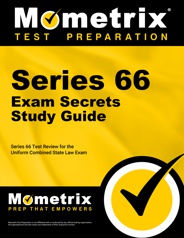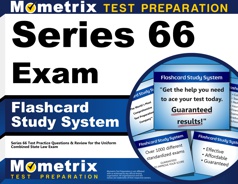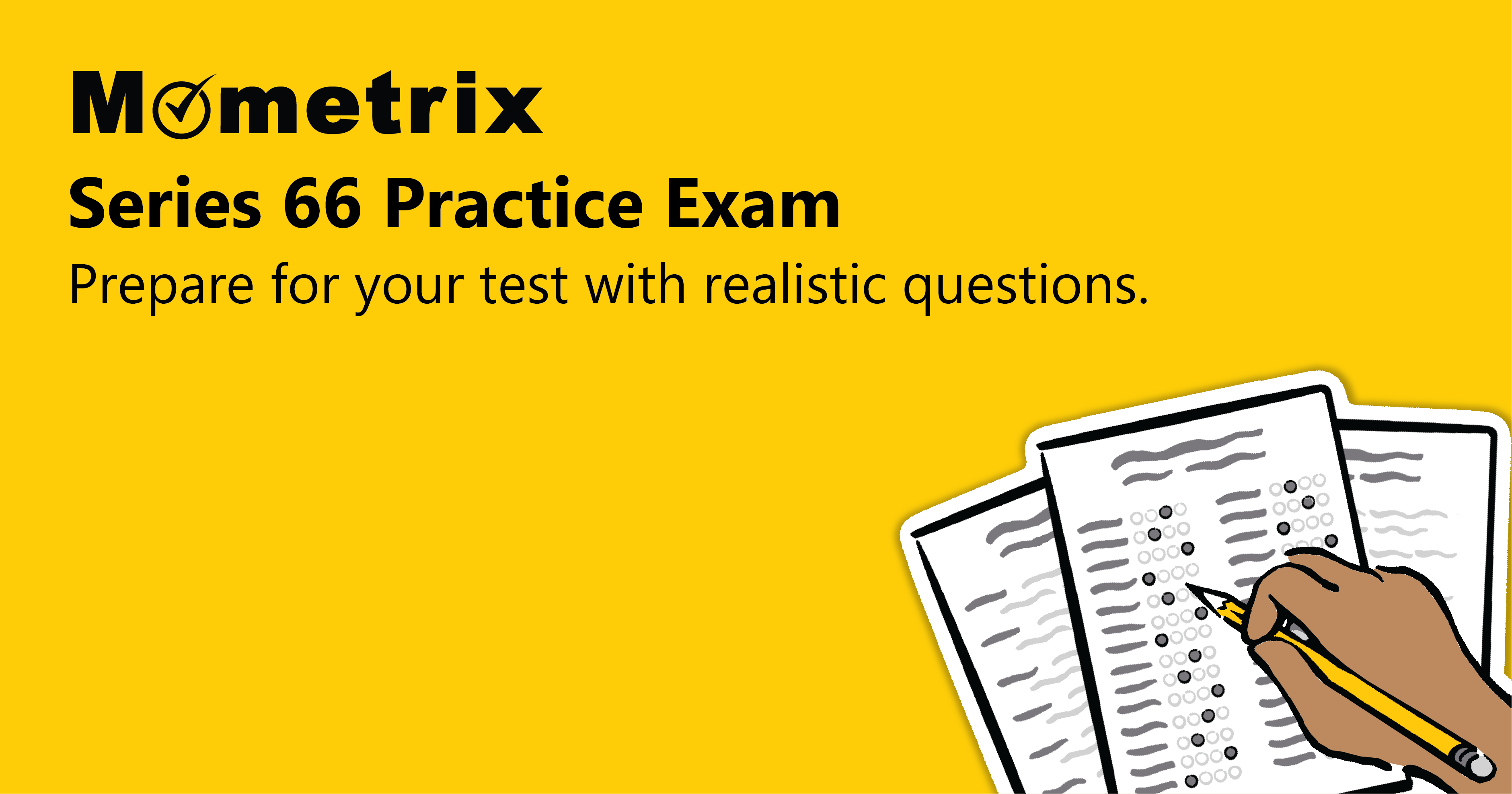The NASAA Uniform Combined State Law exam (Series 66 exam), administered by the Financial Industry Regulatory Authority (FINRA), is used to assess your knowledge and abilities to perform adequately as a securities agent and investment adviser representative.
Click “Start Test” above to take a free Series 66 practice exam!
Series 66 Exam Outline
The Series 66 exam contains 110 multiple-choice questions, 10 of which are unscored, and you will be given a time limit of 2.5 hours. The unscored questions are used by FINRA to evaluate questions for future versions of the exam.
The exam is split into four sections:
I. Economic Factors and Business Information (8%)
The 8 scored questions in this section test your knowledge of various aspects of business and economics.
- Descriptive statistics
- Valuation ratios
- Time value of money concepts
- Financial ratios and their uses
II. Investment Vehicle Characteristics (17%)
The 17 scored questions in this section test your knowledge of various characteristics of investments.
Characteristics of pooled investments
- Tax implications
- Share classes
- Pricing
- Liquidity
- Fee structures
- Relative comparisons
- Benefits and risks
Insurance-based products
- Life insurance
- Annuities
Types and characteristics of cash and cash equivalents
- Insured deposits
- Money market instruments
Types of equity securities
- Common stock
- Preferred, convertible preferred stock, floating rate preferred
Valuation factors of equity securities
- Technical analysis
- Fundamental analysis
- Dividend discount
- Discounted cash flow
Characteristics of equity securities
- Shareholder rights
- Restricted stock and resale restrictions
- Dividends
- Employee stock options
Equity public offering
- Initial public offering (IPO)
- Secondary offering
- Special purpose acquisition companies
Types of pooled investments
- Mutual funds
- Private funds
- Unit investment trusts
- Exchange traded funds
- Real estate investment trusts
Valuation factors of fixed income securities
- Yield-to-call
- Bond ratings
- Duration
- Coupon
- Discounted cash flow
- Conversion valuation
- Yield-to-maturity
- Credit spread
- Maturity
Characteristics, risks, and application of alternative investments
- Inverse funds
- Viatical/life settlements
- Exchange traded notes
- Leveraged funds
- Structured products
Futures and options
- Futures definitions
- Options definitions
Other assets
- Commodities and precious metals
- Digital assets
III. Client Investment Recommendations and Strategies (30%)
The 30 scored questions in this section test your knowledge of various types of clients and what investment recommendations you should make.
Tax considerations
- Individual income tax fundamentals
- Corporate, trust, and estate income tax fundamentals
- Estate tax fundamentals
- Gift tax fundamentals
Capital market theory
- Investment models, theories, and hypotheses
Type of client
- Trusts and estates
- Sole proprietorship
- Individual
- Natural person(s)
- Foundations and charities
- Business entities
ERISA issues
- Investment policy statement
- Fiduciary issues
- Prohibited transactions
Portfolio performance measures
- Current yield
- Returns
- Relevant benchmarks
Special account types
- UTMA/UGMA
- Education-related
- Health-savings accounts
Client profile
- Risk tolerance
- Time horizon
- Financial goals and objectives
- Nonfinancial investment considerations
- Client data gathering
- Current and future financial situation
Portfolio management styles, strategies, and techniques
- Styles
- Strategies
- Techniques
Retirement plans
- Qualified retirement plans
- Individual Retirement Accounts
- Nonqualified retirement plans
Ownership and estate planning techniques
- Beneficiary designation
- Methods of ownership transfer
- Trusts and wills
- Pay-on-death/transfer-on-death
- Qualified domestic relations order
Trading securities
- Role of broker-dealers, market makers, custodians, and exchanges
- Terminology
- Costs of trading securities
IV. Laws, Regulations, and Guidelines Including Prohibition on Unethical Business Practices (45%)
The 45 scored questions in this section test your knowledge of various laws and regulations, with some specific focus on prohibition and unethical business practices.
Regulation of investment advisers
- Registration and post-registration
- Investment adviser representative supervision
- Definitions of an investment adviser
- Notice filing requirements
- Exemptions for exempt reporting advisers and private fund advisors
Regulation of investment adviser representatives
- Registration and post-registration
- Definition of an investment adviser representative
Regulation of broker-dealers
- Definition of a broker-dealer
Regulation of agents of broker-dealers
- Definition of a broker-dealer agent
Regulation of securities and issuers
- Registration and post-registration
- State antifraud authority
- Definition of securities and issuers
- Exemptions
Remedies and administrative provisions
- Authority of state securities administrator
- Administrative actions
- Other penalties and liabilities
Communication with clients and prospects
- Performance guarantees
- Correspondence and advertising
- Disclosures
- Client contracts
- Unlawful representations concerning registrations
Ethical practices and fiduciary obligations
- Custody conditions and obligations
- Compensation
- Cyber security, privacy, and data protection
- Client funds and securities
- Business continuity plan
- Conflicts of interest
- Criminal activities
Check out Mometrix's Series 66 Study Guide
Get practice questions, video tutorials, and detailed study lessons
Get Your Study Guide
Exam Registration
If you are employed or associated with a FINRA member firm, the firm can register you for the exam via a U4 form. If you are not employed or associated with a FINRA member firm, you can open an enrollment window via FINRA’s Test Enrollment Services System (TESS). The exam fee is $177 regardless of which method of registration you choose.
Once your registration request is processed, you will be notified and given a 120-day window to take the exam.
How to Study for the Series 66 Exam
Think you aren’t a good test-taker? Maybe on a study-time crunch? Or just don’t know how to begin studying? Mometrix has designed a new Study Secrets course to help every student, no matter what study scenario you are in. Here’s what you’ll find in the Study Secrets Course:
- Techniques to Conquer Procrastination
- Steps to building a Study Plan custom to your learning style
- 7 Effective Note-Taking Methods
- Test-Taking Tips
- Memory Techniques and Mnemonics
- And much more!
Everyone learns differently, so we’ve tailored our Study Secrets Course to ensure every learner has what they need to prepare for their upcoming exam or semester. Click below to check it out!
Test Day
The Series 66 exam is administered at Prometric testing centers across the United States. You should arrive at the testing center 15-30 minutes early to allow time for check-in. If you arrive late, you will not be able to take the exam and your exam fee will be forfeited.
After you arrive, you will be asked to sign in and provide a valid, government-issued photo ID.
Before you enter the testing room, you will be asked to leave all personal items (cell phone, wallet, keys, food, notes, etc.) in an assigned locker.
Once you are in the testing room, you will be given a small whiteboard, dry-erase markers, and noise-canceling headphones. After the exam begins, you will be allowed to take a break. However, the timer will not be paused during your break.
How the Exam is Scored
Your test score is placed on a scale with all other test-takers’ test scores, and adjustments are made to the score to account for variations in difficulty. You will receive a preliminary score report as soon as you finish the exam.
The passing score is 73, which means you need to answer 73 questions correctly.
Check out Mometrix's Series 66 Flashcards
Get complex subjects broken down into easily understandable concepts
Get Your Flashcards
How to Prepare
How to Study Effectively
Your success on Series 66 test day depends not only on how many hours you put into preparing but also on whether you prepared the right way. It’s good to check along the way to see whether your studying is paying off. One of the most effective ways to do this is by taking Series 66 practice tests to evaluate your progress. Practice tests are useful because they show exactly where you need to improve. Every time you take a free Series 66 exam practice test, pay special attention to these three groups of questions:
- The questions you got wrong
- The ones you had to guess on, even if you guessed right
- The ones you found difficult or slow to work through
This will show you exactly what your weak areas are and where you need to devote more study time. Ask yourself why each of these questions gave you trouble. Was it because you didn’t understand the material? Was it because you didn’t remember the vocabulary? Do you need more repetitions on this type of question to build speed and confidence? Dig into those questions and figure out how you can strengthen your weak areas as you go back to review the material.
Answer Explanations
Additionally, many Series 66 practice tests have a section explaining the answer choices. It can be tempting to read the explanation and think that you now have a good understanding of the concept. However, an explanation likely only covers part of the question’s broader context. Even if the explanation makes sense, go back and investigate every concept related to the question until you’re positive you have a thorough understanding.
Comprehend Each Topic
As you go along, keep in mind that the Series 66 practice test is just that: practice. Memorizing these questions and answers will not be very helpful on the actual test because it is unlikely to have any of the same exact questions. If you only know the right answers to the sample questions, you won’t be prepared for the real thing. Study the concepts until you understand them fully, and then you’ll be able to answer any question that shows up on the test.
Strategy for Series 66 Practice
When you’re ready to start taking practice tests, follow this strategy:
- Remove Limitations. Take the first test with no time constraints and with your notes and Series 66 study guide handy. Take your time and focus on applying the strategies you’ve learned.
- Time Yourself. Take the second practice test “open book” as well, but set a timer and practice pacing yourself to finish in time.
- Simulate Test Day. Take any other practice tests as if it were test day. Set a timer and put away your study materials. Sit at a table or desk in a quiet room, imagine yourself at the testing center, and answer questions as quickly and accurately as possible.
- Keep Practicing. Keep taking practice tests on a regular basis until you run out of practice tests or it’s time for the actual test. Your mind will be ready for the schedule and stress of test day, and you’ll be able to focus on recalling the material you’ve learned.
FAQs
Q
What is Series 66?
A
The Series 66 exam, also known as the Uniform Combined State Law exam, is taken by those pursuing licensure as a financial professional with state-level authority.
Q
How many questions are on the Series 66 exam?
A
There are 110 multiple-choice questions on the exam.
Q
How long is the Series 66 exam?
A
The time limit for the exam is 2.5 hours.
Q
What is the passing score for the Series 66 exam?
A
To pass the exam, you must achieve a raw score of at least 73.
Q
How much does the Series 66 exam cost?
A
The examination fee is $177.
Mometrix Test Preparation is not affiliated with or endorsed by any official testing organization. All organizational and test names are trademarks of their respective owners.



